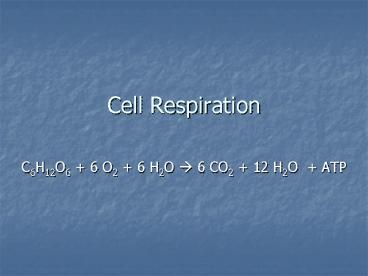Cell Respiration
1 / 24
Title: Cell Respiration
1
Cell Respiration
- C6H12O6 6 O2 6 H2O ? 6 CO2 12 H2O ATP
2
Overview 4 main processes
- Glycolysis
- Pyruvate oxidation
- Citric Acid Cycle
- Electron Transport Chain
3
Glycolysis
- Sugar splitting 1 molecule of glucose (6-C)
is split into 2 pyruvates (3-C) - Occurs in cytosol
- ATP, NAD, and Pi float freely
- Series of reactions catalyzed by specific enzymes
4
1st phase of Glycolysis is Endergonic
- Requires input of ATP
- Glucose is stable, not readily broken down
- 2 phosphorylation rxns. transfer P from ATP to
sugar ? fructose 1,6-biphosphate
5
- Fructose 1,6-biphosphate broken down into 2 3-C
molecules dihydroxyacetone phosphate and
glyceraldehyde-3-phosphate (G3P) - Dihydroxyacetone phosphate converted to G3P
- OVERALL Glucose 2ATP ? 2 G3P 2 ADP
6
2nd phase of Glycolysis is Exergonic
- G3P is oxidized to produce NADH H
- Since 2 G3P, 2 NADH are produced (used later to
produce ATP) - Substrate-level phosphorylation- P is
transferred from intermediate to ADP - 2x per G3P
- Total of 4 ATP made
7
Glycolysis Summary
- http//programs.northlandcollege.edu/biology/Biolo
gy1111/animations/glycolysis.html - OVERALL REACTION
- http//www.science.smith.edu/departments/Biology/B
io231/glycolysis.html - Glucose 2 ATP ? 2 pyruvate 2NADH 4 ATP
- (net gain of 2 ATP)
8
Remaining Processes occur in the Mitochondria
9
Pyruvate Oxidation
- Pyruvate enter mitochondria in eukaryotes
- Pyruvate Dehydrogenase catalyses oxidative
decarboxylation - Carboxyl removed as CO2
- 2-C fragment becomes oxidized creating NADH
- 2-C acetyl group attached to coenzyme A
10
Overall
- 2 puruvate 2 NAD 2 CoA ?
- 2 acetyl CoA 2 NADH 2 CO2
11
Citric Acid Cycle
- 1st reaction acetyl CoA transfers 2-C acetyl
group to 4-C oxaloacetate to get citrate - Series of reactions
- 2 CO2 are removed yielding 4-C compound
- Oxidation occurs yielding 3 NADH and 1 FADH2 per
acetyl coA - 1 ATP produced by substrate level phosphorylation
- Oxaloacetate is regenerated
12
Citric Acid Cycle
13
Electron Transport Chain
- ETC is series of electron carriers embedded in
inner mitochondrial membrane of eukaryotes
(plasma membrane of prokaryotes) - Electrons produced during glycolysis, pyruvate
oxidation, and Citric Acid Cycle enter ETC via
carrier molecules
14
Overview of ETC
- High energy electrons are passed along ETC in
series of exergonic reactions - Energy from these rxns. drives ATP synthesis
(endergonic) - This is oxidative phosphorylation result of
redox rxns.
15
- 3 of the 4 complexes are proton pumps pump H
into the intermembrane space - Complex I accepts e- from NADH and transfers it
via ubiquinone (aka coenzyme Q) to Complex III - Complex II accepts e- from FADH2 and transfers
via ubiquinone
16
- Complex III accepts e- from ubiquinone and
transfers them via cytochrome c to Complex IV - Final Electron acceptor is Oxygen (1/2 O2) it
accepts 2 e- and combines with 2 protons to
create water - Aerobic respiration requires O2 without it as
final e- acceptor, entire chain backs up
17
(No Transcript)
18
- http//www.science.smith.edu/departments/Biology/B
io231/etc.html - http//highered.mcgraw-hill.com/sites/0072437316/s
tudent_view0/chapter9/animations.html - http//www.stolaf.edu/people/giannini/flashanimat/
metabolism/mido20e20transport.swf
19
Chemiosmosis
- ETC is coupled to ATP synthesis by proton
gradient - Concentration of H in intermembrane space is
much higher than matrix - H diffuses down its gradient through ATP
synthase - exergonic
20
- Exergonic diffusion coupled to endergonic ATP
synthesis - http//vcell.ndsu.nodak.edu/animations/atpgradient
/movie.htm - http//www.stolaf.edu/people/giannini/flashanimat/
metabolism/atpsyn1.swf - http//www.stolaf.edu/people/giannini/flashanimat/
metabolism/atpsyn2.swf
21
SO WHATS THE POINT??
- Glycolysis gives us 2 ATP (net) 2 NADH
- Pyruvate oxidation 2 NADH 2 CO2
- Citric Acid Cycle 2 ATP 4 CO2 6 NADH
2FADH2
22
ADDING UP ATP
- Each NADH yields 3 ATP, so
- Glycolysis 2 NADH ? 6 ATP
- except for most eukaryotic cells which shuttle
e- of NADH across mit. Mem., costing 1 ATP/NADH - Pyruvate oxidation 2 NADH ? 6 ATP
- Citric Acid Cycle 6 NADH ? 18 ATP
- Each FADH2 yields 2 ATP
- Citric Acid Cycle 2 FADH2 ? 4 ATP
23
GRAND TOTALS
- Glycolysis 2 ATP
- Citric Acid Cycle 2 ATP
- ETC 32 34 ATP
- Aerobic Respiration 36 38 ATP
24
Efficiency (i.e., thermodynamics)
- Burning glucose releases 686 kcal/mol heat
- Free energy in phosphate bonds of ATP 7.6 kcal
- 7.6 kcal/mol ATP x 36 ATP 274 kcal/mol
- Efficiency of aerobic resp. 274/686 40
- Rest is lost as heat































